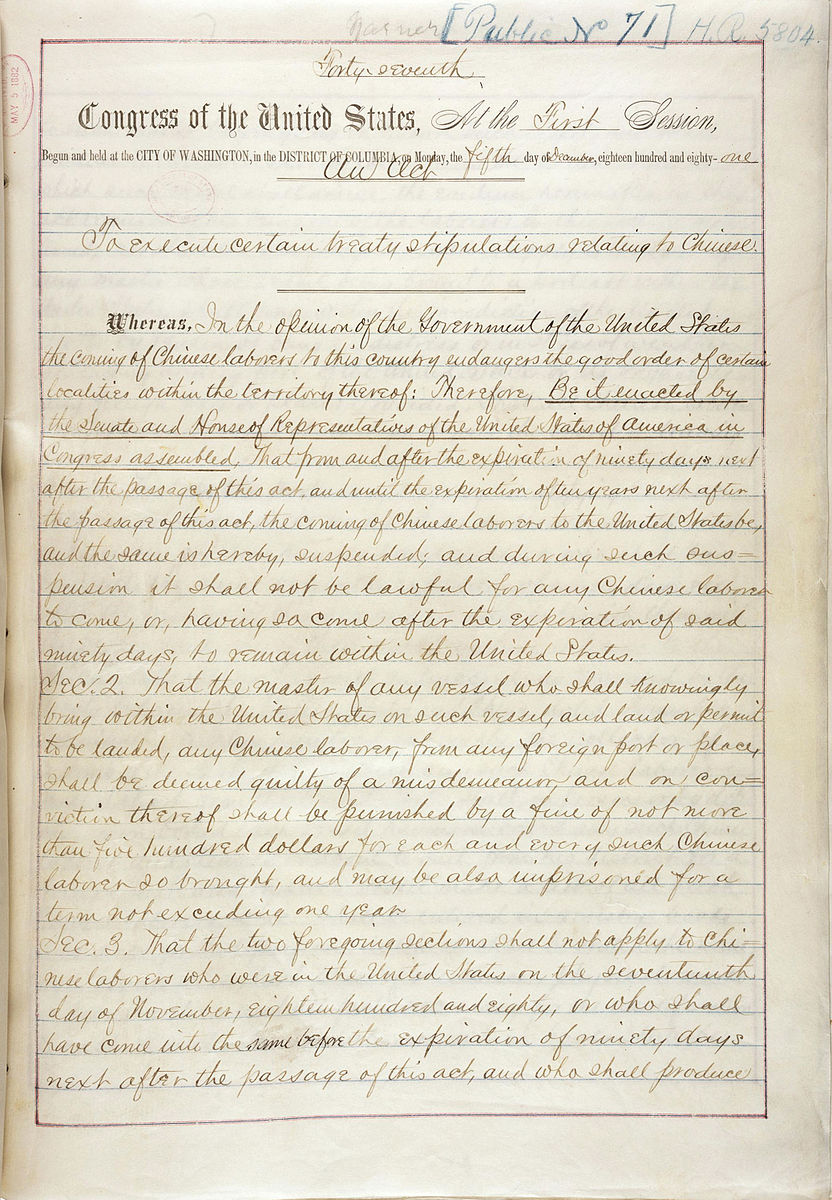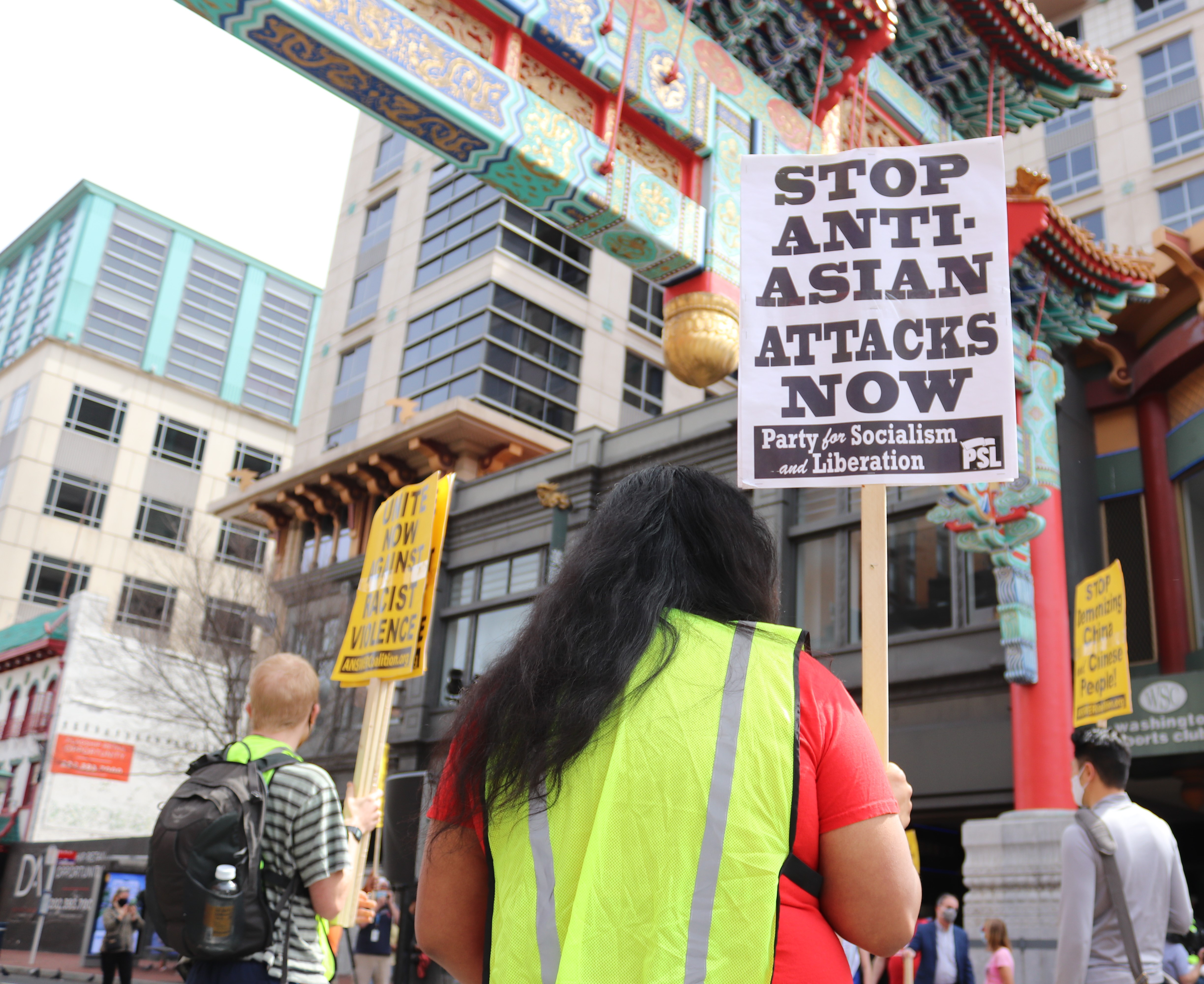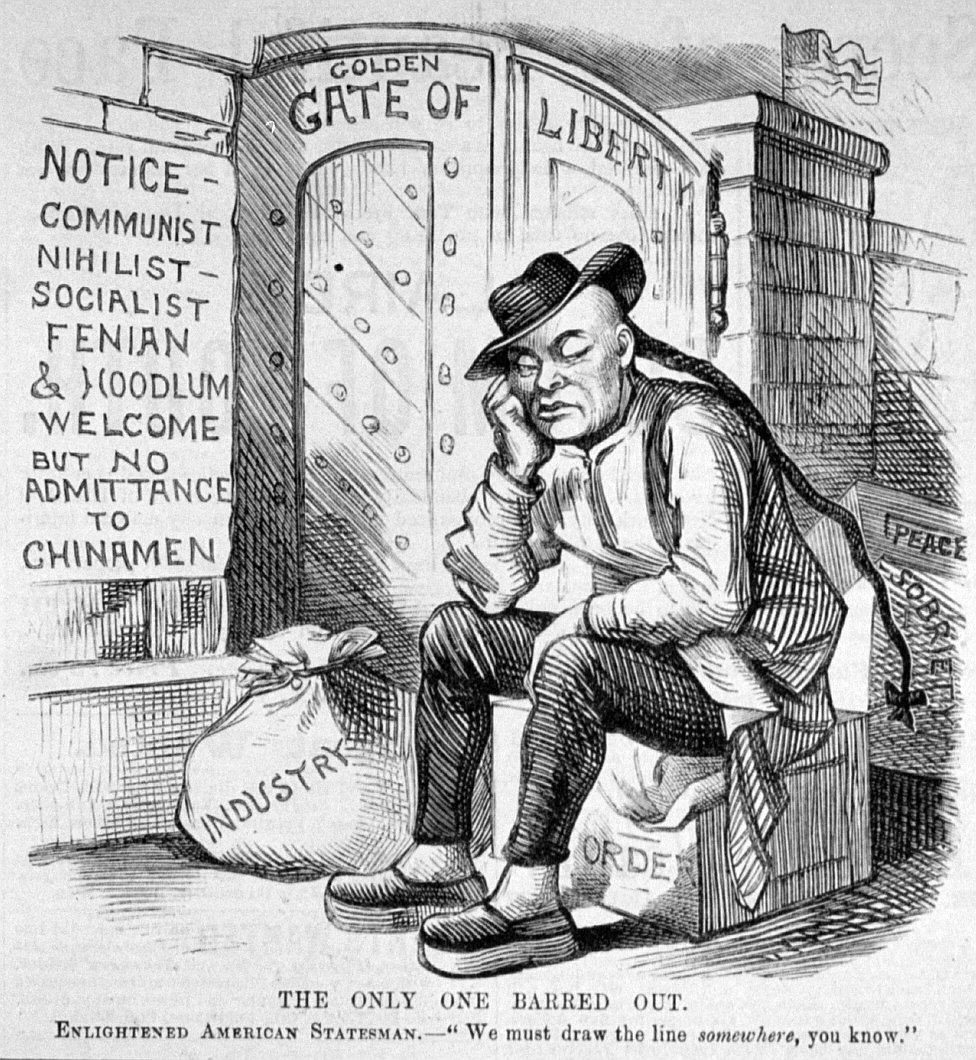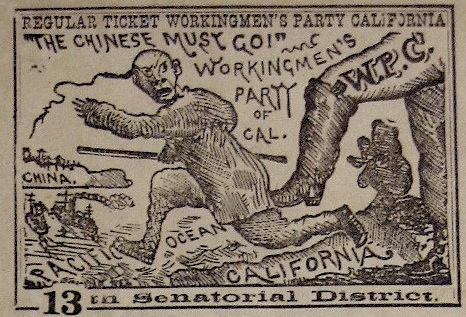Grade: 7-10Subject:
U.S. History, Social Studies
Number of Lessons/Activities: 4
Chinese immigrants began arriving to the United States in the early 1800s to fill the need for cheap labor. Soon, white workers began to see them as a source of competition. Amidst a climate of anti-Chinese sentiment, the U.S. passed several pieces of legislation to exclude Chinese immigrants from entering the country beginning in the 1870s. In 1882, the U.S. passed the Chinese Exclusion Act, the first in a series of laws explicitly used to limit immigration based on race. Other immigration laws followed to exclude additional Asian groups. In this lesson, students will examine the causes and effects of exclusion laws targeting early Asian immigrants. They will research related events and legislation to explore the historical and political contexts of the anti-Chinese exclusion acts.
Why did the United States pass exclusion laws against Asian immigrants and how did these laws impact APIDA people’s ability to become U.S. citizens?
Students will:
- Examine the causes and effects of exclusion laws targeting early Asian immigrants.
- Analyze the barriers APIDA people have and continue to face in pursuing citizenship and membership in the United States.
Content Warning:
This lesson will include discussions and depictions of xenophobia, Sinophobia, race-based hate, and racial violence. If needed, provide a content or a trigger warning so that students are aware of potentially traumatic material. Also, allow students time to process and provide them an opportunity to journal their thoughts and feelings. If available, work with your school’s mental health professionals to provide counseling as needed.
Citizenship and Acts of Exclusion Against the Chinese Essay:
Background:
Poverty and famine forced many Chinese people to seek economic opportunities in the United States. At first the Chinese were welcomed as cheap labor used to fulfill the idea of “manifest destiny” held by many white Americans at the time. The Burlingame Treaty of 1868, an agreement between China and the United States, allowed the Chinese to freely enter the U.S. to ensure “a sufficient supply of Chinese labor.” These Chinese men were recruited to work in a variety of jobs and their work was essential to the country’s westward expansion. However, the Chinese received little credit and were often the victims of hate crimes and anti-Asian laws. Many of these early Chinese laborers came with the intent to work, send money home, and eventually return to China. But, many Chinese laborers later decided to instead settle in the United States; as such, they sought ways to bring their wives and children over. This created a panic, as white citizens now saw the Chinese as an invading threat, fearing the Chinese would steal their jobs and tarnish their morality.
Essay:
In the early 1800s, many people left China in order to flee from famine and wars. They sought better economic opportunities in the United States which was experiencing growth due to the discovery of gold in California and the building of the Transcontinental Railroad. With the conclusion of the Civil War marking the end of slavery in the U.S., Chinese immigrants filled the need for cheap labor.
In the 1870s, a financial panic hit the U.S. and unemployment skyrocketed. Labor unions of white workers formed and began to see the Chinese workers as competition. Violence occurred during this era in terms of bodily harm and property damage. Gangs would roam through the streets, go to Chinatown, and assault people. They would attack Chinese businesses and burn them down. There were riots, lynchings, burnings, and massacres of Chinese people.
White labor unions gained political power and lobbied for laws to limit the
immigration of the Chinese. At that time, white people and former African slaves not born in the U.S. were able to naturalize and become citizens. Asian immigrants however were excluded. Accordingly, they had neither the political power nor representation to make sure their needs and safety were guarded by local, state, or federal governments.
To curb Asian immigration, the Page Act of 1875 was signed into law by President Ulysses S. Grant, ending the United States’ open immigration policy. In practice, the Page Act restricted the immigration of Chinese women who were all assumed to be “
immoral.” Banning the immigration of Chinese women prevented Chinese men from having families in the United States. Additionally, there were laws against interracial marriages. The outcome resulted in the formation of “
bachelor societies'' among the Chinese male population. Even married men suffered under the Page Act, as their wives and children were banned from immigrating. Fathers were separated from their families. As such, the Page Act thwarted family formation and reunification.
The Page Act was ground-breaking in that it led to more anti-Asian laws, most notably the Chinese
Exclusion Act. Signed on May 6, 1882 by President Chester Arthur, the Chinese Exclusion Act was the first in a series of laws explicitly used to limit immigration based on race.
When the Chinese Exclusion Act was signed, it reflected an almost widespread sentiment of “the Chinese Must Go.” With much
scapegoating and stereotyping at the time, the Exclusion Act restricted Chinese workers from entering the country and added additional stipulations for other Chinese wanting to enter the country. A key clause stated: “The coming of Chinese laborers to the United States be, and the same is hereby, suspended; and during such suspension it shall not be lawful for any Chinese laborers to come.” However, the law did allow for the entry of “students, teachers, travelers, merchants, and diplomats,” and established laws and mechanisms to arrest and deport those found in the country unlawfully, laying the foundation for the detention and deportation of certain immigrants that continues to this day.
Although anti-Chinese sentiment was overwhelming, there were advocates for Chinese and Asian immigration, such as Frederick Douglass, an African American abolitionist, orator, writer, and statesman. Douglass became a national leader in the abolitionist movement after escaping from slavery in Maryland. In the late 1860s, as anti-Chinese sentiments grew, he spoke not only in favor of Chinese immigration, and migration more broadly, but also in favor of allowing immigrants to gain citizenship, the right to vote, and hold public office.
However, anti-Chinese fervor was the dominant narrative. The Chinese Exclusion Act was not only renewed and made permanent in the following decades, but also set a precedent for restrictive immigration and other discriminatory laws. Other immigration laws to exclude additional Asian groups were enacted, including the Immigration Act of 1917 (Asiatic Barred Zone Act), which banned immigration from the Middle East and Southeast Asia, and lumped all Asians, despite their various ethnicities and cultures, together as “Asiatic.”
In addition, racist laws and practices forbade Asians from marrying white people, attending white schools, living in certain parts of cities, testifying in court against white people, owning land and property, and holding commercial and professional licenses. During this time, Asian immigrants were not eligible to gain citizenship through naturalization, which meant they were unable to vote. This lack of political power meant discriminatory laws could be enacted and enforced against them. For example, Alien land laws specifically prevented “aliens ineligible for citizenship" from owning or leasing land, which targeted Asian immigrants. These laws and policies upheld white supremacy by excluding communities of color and made it difficult for them to gain financial security, electoral power, and long-term stability in the U.S.
The Chinese Exclusion Act was eventually repealed in 1943 when the U.S. sought to build an allyship with China against Japan during World War II. The discriminatory practices set by the Chinese exclusion laws were later applied to Japanese Americans who were forcefully removed from their homes and incarcerated. Today, Asian Pacific Islander Desi American (APIDA) communities are still targets of exclusion, marginalization, and discrimination.
Bibiliography:
Lee, Catherine. “‘Where the Danger Lies’: Race, Gender, and Chinese and Japanese Exclusion in the United States, 1870-1924.”
Sociological Forum 25, vol. 25no. 2, 2010, pp. 248-71. JSTOR,
http://www.jstor.org/stable/40783393.
- Bachelor: a male who is not or has never been married
- Exclusion: the act or an instance of preventing or barring from entrance
- Immigration: traveling to a country for the purpose of permanent residence there
- Immoral: evil, sinful, or otherwise wrong behavior
- Scapegoating: singling out a person or group for unmerited blame and consequent negative treatment
- Xenophobia: fear and hatred of strangers or foreigners, or of anything that is strange or foreign
- Why did the Chinese immigrate to the United States?
- How were Chinese laborers treated in the United States?
- What were the purposes of the exclusion laws? What were the purposes of denying immigration and citizenship to a specific group of people?
- What is the significance of banning people from immigrating? How did this affect early Asian immigrants’ ability to fully participate in “American” society?
- How were the exclusion acts an example of xenophobia and scapegoating?
- How are exclusion laws connected to citizenship?
- How does the history of exclusion impact modern day immigration?
- How does Chinese exclusion impact other communities of color?
This 1882 political cartoon shows a Chinese man surrounded by luggage labeled “Industry,” “Order,” “Sobriety,” and “Peace.” He is being excluded from entry to the “Golden Gate of Liberty.”
Credit: “The only one barred out.” Frank Leslie's illustrated newspaper, vol. 54 (1882 April 1), p. 96., Public domain, via Wikimedia Commons. Library of Congress.
Activity 1: Understanding Exclusion
- Have students do a quickwrite about a time they were excluded from something they wanted to do or be a part of. As a whole group, discuss reasons why people are excluded from things and how people may feel about being excluded.
- NOTE TO TEACHER: Allow students the right to pass on the activity as they should not be forced to share personal information. Encourage them to talk about general ideas and to not share personal details.
- Have students brainstorm a list of ways in which the government or society has excluded certain groups of people. Inform students that this lesson will focus on exclusion laws that were unfairly applied to early Asian immigrants.
This 1872 poster for the Regular Ticket Workingmen's Party California reads “The Chinese Must Go!” reflecting a popular political message of the time.
Credit: The Workingmen's Party of California, Public domain, via Wikimedia Commons
Activity 2: Unpacking the Causes and Effects of Exclusion Acts
- Explain to students that there were a lot of anti-Chinese sentiments in the late 1850s:
- Read this 1878 quote by Denis Kearney, an Irish immigrant and leader of California’s Workingmen’s Party: “California must be all American or all Chinese. We are resolved that it shall be American, and are prepared to make it so.” Kearney ended many of his speeches with the slogan, “The Chinese must go.”
- Optional: Have students study the article in its entirety: https://www.digitalhistory.uh.edu/disp_textbook_print.cfm?smtid=3&psid=24
- Explain that Horace Page, a politician from California, used the slogan, “Keep them out!"
- Ask students: How do these two slogans create a culture of hate against Chinese immigrants?
- Have students read the essay on Chinese Exclusion Acts (see worksheet entitled, “Essay: Citizenship and Acts of Exclusion Against the Chinese”).
- Explain to students that causes are things or actions that bring about a result.
- Explain to students that effects are consequences or results.
- Direct students to look for the causes and effects as they read the essay and to underline the causes and effects on the worksheet. Inform students that there are multiple causes and effects, and that effects become causes for other effects as well.
- NOTE TO TEACHER: If you have limited classroom time, have students complete the reading as a homework assignment the night before you implement this lesson.
- Have students complete the worksheet entitled “Exclusion: Causes and Effects.” This can be done independently, in small groups, or as a whole group. Then review and display the answers as a class (see Answer Key):
- Ask students: What were the exclusion acts? Record notes in the middle of the worksheet.
- Ask students: What were the causes or reasons for why the exclusion acts were passed? Record responses in the boxes in the top half of the worksheet.
- Ask students: What were the effects or consequences of the exclusion acts? What happened as a result of the exclusion acts? Record responses in the boxes in the bottom half of the worksheet.
- Remind students to refer to the text.
- Facilitate a discussion about the essay and the worksheet using the Discussion Questions.
- NOTE TO TEACHERS: If time permits and if students need more support, watch the video in The Asian American Education Project’s lesson entitled, “Chinese Exclusion Act: The Exclusion of Asians, Pacific Islanders, and Chinese Women.” As an optional activity or for homework, pause at the propaganda depicted in the video clip and discuss how the media has vilified and scapegoated Chinese immigrants by depicting them as a threat to the United States; then, have students create a cartoon, one that shows a more accurate depiction of Chinese people and one that counters the anti-Chinese cartoons of the time.

The first page of the 1882 Chinese Exclusion Act. The Chinese Exclusion Act was preceded and followed by several pieces of legislation aimed at excluding Chinese and Asian immigration.
Credit: General Records of the United States Government; Record Group 11; National Archives (Public Domain)
Activity 3: Contextualizing Acts of Exclusion
- Have students learn more about the historical and political contexts of the anti-Chinese exclusion acts. Have students work in small groups and assign each one of the following events:
- 1868-1880: Burlingame Treaty
- 1892-1943: Geary Act
- 1910-1940: Angel Island Immigration Center
- 1917-1924: Immigration Act of 1917 (Asiatic Barred Zone Act)
- 1924-1965: Immigration Act of 1924 (Johnson-Reed Act)
- 1943-1965: Magnuson Act or Chinese Exclusion Repeal Act
- 1952-1965: Immigration and Nationality Act of 1965 (McCarran-Walter Act)
- 1965-present: Immigration and Nationality Act (Hart-Celler Act)
- 1956-1965: Chinese Confession Program
- Distribute the worksheet entitled, “Exclusion: Event Research Chart.” Have students research each event by answering the following questions and completing the worksheet:
- What is the event? What happened?
- Why did the event happen? What were the causes?
- How or why did the event end?
- What happened after the event? What were its effects?
- How did the event affect APIDA immigrants?
- Is this event a cause or effect of the Page Act of 1875 and/or the Chinese Exclusion Act of 1882? (Make sure students provide evidence for their thinking.)
- Have students create a poster or presentation about their assigned event. Have them present each event in chronological order or host a gallery walk.
- Facilitate a discussion about the above activity using the following prompts:
- What are some examples of how events build upon one another?
- How did sentiments about Asian immigration change over time? What caused these sentiments? What caused the changes?
- How were Asians or Asian Americans treated? How were they exploited?
- How are other groups of people impacted by how early Chinese immigrants were treated?
- NOTE TO TEACHER: If time permits, explain to students that one of the tragic effects of the exclusion laws is the violence and hate they perpetuated against the Chinese. Consider implementing The Asian American Education Project’s lesson entitled, “Chinese Massacre of 1871: Not an Isolated Event.”
- Assign students the following task for homework as an assessment: “The late 19th century is known as a time when the U.S. experienced great industrial growth, with some enjoying more economic prosperity than others, and cities growing rapidly as immigration and the population increased. In one page, explain how the Asian exclusion acts counter this image of the United States.”

This photo shows people gathered at a rally at the Chinatown Archway in Washington, DC on March 27, 2021. One person is holding a sign that reads “Stop Anti-Asian Attacks Now.”
Credit: Elvert Barnes Photography,
CC BY-SA 2.0, via Wikimedia Commons
Activity 4: Persisting Impacts of Exclusion
- Ask students: In what ways are APIDA communities still feeling the impacts from these exclusion laws? How are APIDA communities still being excluded or scapegoated?
- NOTE TO TEACHER: If you or your students need more support in understanding the exclusion acts, read this article by The Asian American Education Project staff members entitled, “Excluded From History: The Page Act of 1875.”
- If you are teaching this lesson as part of the Citizenship unit: Inform students they will be learning about how APIDA communities were denied access to education and how they fought for desegregation.



